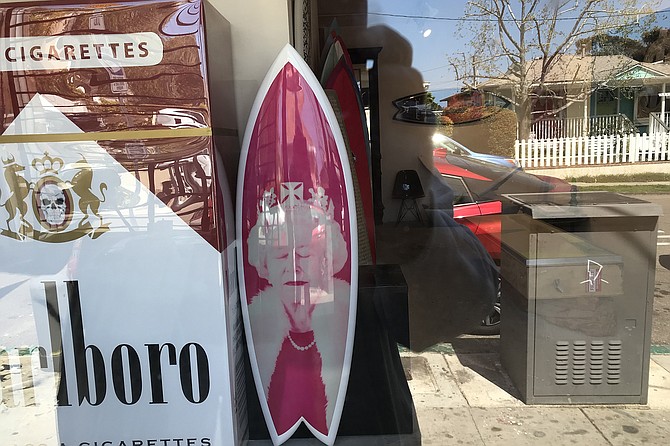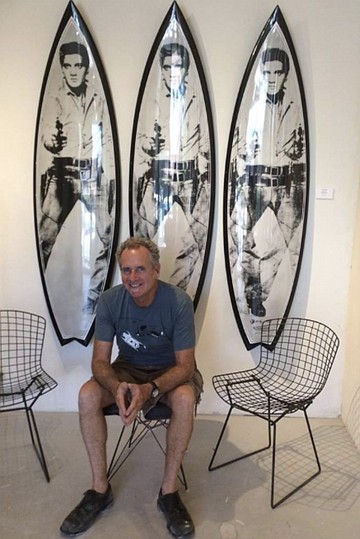 Facebook
Facebook
 X
X
 Instagram
Instagram
 TikTok
TikTok
 Youtube
Youtube

My buddy Erik and I do a double take.
“Did you see that?” Erik asks? “The Queen of England, on a surfboard?”
I turn around. There she is sure enough, and wow! She has her eyes closed, looking like, “What on God’s earth am I doing on a surfboard?”
Actually, it’s a bigger-than-life photo of her, crown and all, laminated onto this really cool-looking surfboard.
“For a surfboard, that’s weird art,” says Erik.
We’re in La Jolla, Westbourne Street, in front of a prosperous-looking boutique surf shop. “You’re looking at one of the most revered shaper shops in the country,” says Erik. “Tim Bessell. He has been making boards here for 50 years. And now, many of them are regarded as art as much as surfboards.”
We knock on the door, but no sign of the man himself. I end up calling him next day.
“I’m 63, I started making surfboards at 13 years old, I’ve been making them for 50 years,” Bessell says. “By now, I’ve made 50,000 of them.” These days, he sells to a lot of famous people such as Mick Jagger and Kate Moss. And the price? “‘The Queen’ board would fetch about nine and a half. Because it is functional art.”
He means nine and a half thousand dollars.

“Boards as art? Oh sure. Really big,” he says. “My boards are not sold in surf-art galleries. They’re sold in art-art galleries. And you can quote me that functional art is far superior to fine art, because it really has to work. If you ever go to MoMA, you’ll see a race car, and it’s up on the wall. They understand that functional art is real art.”
One of Bessell’s biggest coups was getting the exclusive rights to feature Andy Warhol art on his surfboards.
He makes Warhol boards for a maximum of twelve boards per art piece reproduced. In a way, it’s natural. “Andy Warhol moved to La Jolla in 1968 to make a movie called San Diego Surf,” Bessell says.
That movie did not get finished because right after Warhol went back to New York, Valerie Solanas shot and wounded him.”
And what a selection! “Andy Warhol produced 48,000 images. I have a lot of say-so on what I put on my boards, and the Warhol foundation either approves or doesn’t approve. Now we have over 50 Warhol designs. But you can’t go wrong with Andy’s Marilyn, or with Andy’s Elvis.”
So how did he come to discover the Queen? “Well, the Queen came to me. I have a dealer in London, Justin Easton, from the Drang Gallery. They sell really good artists. Justin Easton represents Christopher Levine, who’s very famous for photographing the queen. That closed-eye portrait was his.”
“But who’s going to buy a $10,000 picture of the queen who’s forever going to be there tut-tutting on your surfboard?” I say to Erik as we head out of La Jolla.
“Well, at least she’d be someone to talk to,” Erik says.


My buddy Erik and I do a double take.
“Did you see that?” Erik asks? “The Queen of England, on a surfboard?”
I turn around. There she is sure enough, and wow! She has her eyes closed, looking like, “What on God’s earth am I doing on a surfboard?”
Actually, it’s a bigger-than-life photo of her, crown and all, laminated onto this really cool-looking surfboard.
“For a surfboard, that’s weird art,” says Erik.
We’re in La Jolla, Westbourne Street, in front of a prosperous-looking boutique surf shop. “You’re looking at one of the most revered shaper shops in the country,” says Erik. “Tim Bessell. He has been making boards here for 50 years. And now, many of them are regarded as art as much as surfboards.”
We knock on the door, but no sign of the man himself. I end up calling him next day.
“I’m 63, I started making surfboards at 13 years old, I’ve been making them for 50 years,” Bessell says. “By now, I’ve made 50,000 of them.” These days, he sells to a lot of famous people such as Mick Jagger and Kate Moss. And the price? “‘The Queen’ board would fetch about nine and a half. Because it is functional art.”
He means nine and a half thousand dollars.

“Boards as art? Oh sure. Really big,” he says. “My boards are not sold in surf-art galleries. They’re sold in art-art galleries. And you can quote me that functional art is far superior to fine art, because it really has to work. If you ever go to MoMA, you’ll see a race car, and it’s up on the wall. They understand that functional art is real art.”
One of Bessell’s biggest coups was getting the exclusive rights to feature Andy Warhol art on his surfboards.
He makes Warhol boards for a maximum of twelve boards per art piece reproduced. In a way, it’s natural. “Andy Warhol moved to La Jolla in 1968 to make a movie called San Diego Surf,” Bessell says.
That movie did not get finished because right after Warhol went back to New York, Valerie Solanas shot and wounded him.”
And what a selection! “Andy Warhol produced 48,000 images. I have a lot of say-so on what I put on my boards, and the Warhol foundation either approves or doesn’t approve. Now we have over 50 Warhol designs. But you can’t go wrong with Andy’s Marilyn, or with Andy’s Elvis.”
So how did he come to discover the Queen? “Well, the Queen came to me. I have a dealer in London, Justin Easton, from the Drang Gallery. They sell really good artists. Justin Easton represents Christopher Levine, who’s very famous for photographing the queen. That closed-eye portrait was his.”
“But who’s going to buy a $10,000 picture of the queen who’s forever going to be there tut-tutting on your surfboard?” I say to Erik as we head out of La Jolla.
“Well, at least she’d be someone to talk to,” Erik says.
Comments